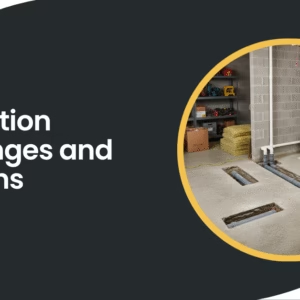The dream had always been clear for Mark. He pictured a spacious workshop behind his Parsons home—a quiet space for his woodworking passion. For months, he sketched layouts and imagined the scent of fresh sawdust. When the moment felt right, he called a local contractor, eager to begin. But excitement quickly turned into uncertainty. “How long will this take?” he wondered.
The contractor offered an estimate, but it felt vague. Mark soon realized that knowing the shop construction timeline in Parsons was key to setting expectations. The same concern often surfaces in commercial construction in Parsons as well. Like Mark, many homeowners planning on building a shop in Parsons face similar questions.
This blog walks you through each step of the process, clearly explaining what impacts the timeline and how to plan.
Understanding the Shop Construction Timeline in Parsons
Constructing a shop in Parsons involves several key phases, each with its own set of requirements and potential challenges. Here’s a breakdown of the typical timeline:
Initial Planning and Design Phase
Before any physical work begins, the initial planning and design phase is paramount. This stage involves several critical steps, starting with conceptualization.
- What exactly do you envision for your shop?
- What size will it be?
- What specific features do you need?
Once you have a clear idea, the design process begins. This often involves working with an architect or designer to create detailed blueprints that meet local zoning regulations and your specific requirements. Permitting is another crucial aspect of this phase. Obtaining the necessary permits from the local authorities can sometimes be a lengthy process. It depends on the complexity of your project and the current workload of the permitting office. A well-defined plan and proactive approach to permitting can significantly impact the overall shop construction timeline, Parsons.
Site Preparation: Laying the Groundwork
Once the plans are finalized and permits are secured, the next step is site preparation. This involves clearing the designated area of any obstacles, such as trees or debris. Depending on the terrain, some grading or leveling might be necessary to create a suitable foundation for your shop.
Soil testing might also be conducted to confirm that the ground can support the structure. This phase, while seemingly straightforward, is crucial for the structural integrity of your future shop. Efficient site preparation sets the stage for a smoother and potentially faster construction process. How might unforeseen site conditions impact the projected timeline?
Foundation Construction: Building a Solid Base
The foundation is the backbone of any building, and your shop is no exception. The type of foundation will depend on factors like soil conditions, the size of your shop, and your budget. Common foundation types include concrete slabs, crawl spaces, and basements.
The construction of the foundation involves excavation, forming, pouring concrete, and allowing it to cure properly. This stage requires precision and adherence to building codes to confirm a stable and long-lasting structure. The duration of this phase can vary depending on the complexity of the chosen foundation type and weather conditions.
Framing the Structure: Defining the Shape
With a solid foundation in place, the next phase is framing. This involves constructing the skeletal framework of your shop using materials like wood or steel. The framing process defines the walls, roof, and overall shape of the building.
Skilled carpenters or framing crews assemble the structural elements according to the blueprints. The speed of the framing stage can depend on the size and complexity of the design, as well as the efficiency of the construction team. Observing the frame take shape is often when the vision of your new shop truly starts to materialize.
Exterior Finishes: Weatherproofing and Aesthetics
Once the framing is complete, the focus shifts to the exterior finishes. This includes installing the roof, siding, windows, and doors. These elements not only protect the interior from the elements but also contribute significantly to the aesthetic appeal of your shop.
The choice of materials for roofing and siding can also impact the timeline, as some materials are quicker to install than others. Proper installation of exterior finishes is crucial for weatherproofing and the long-term durability of your shop.
Interior Build-Out: Creating the Functional Space
With the exterior enclosed, the interior build-out begins. This phase encompasses a range of tasks, including installing insulation, electrical wiring, plumbing (if applicable), drywall, flooring, and interior doors. This is where the raw structure transforms into a functional space. The timeline for the interior build-out can vary greatly depending on the complexity of the features you desire, such as specialized electrical setups for machinery or specific plumbing needs. Careful coordination between different trades (electricians, plumbers, etc.) is essential to keep this phase on schedule.
Final Touches and Inspections: Completing the Project
The final stages of building a shop in Parsons involve adding the finishing touches, such as painting, installing fixtures, and any custom elements you might have planned. Once the construction is complete, final inspections are conducted by local authorities to confirm the shop meets all building codes and safety regulations. Addressing any issues identified during inspections is crucial before the project can be officially considered finished. This final phase, while often exciting as the end is in sight, requires attention to detail to confirm everything is up to standard.
Table: Comparing Typical Timeline Stages
| Construction Stage | Typical Duration | Potential Delays |
| Planning & Design | 1-3 months | Permitting delays, design revisions |
| Site Preparation | 1-2 weeks | Unexpected site conditions, weather |
| Foundation Construction | 2-4 weeks | Weather, complexity of foundation |
| Framing | 2-4 weeks | Material availability, crew scheduling |
| Exterior Finishes | 3-6 weeks | Weather, material delivery |
| Interior Build-Out | 4-8 weeks | Complexity of finishes, subcontractor scheduling |
| Final Touches & Inspections | 1-2 weeks | Inspection findings |
Please note that these are estimated durations and can vary based on the specific details of your project.
Factors Influencing the Shop Construction Timeline
Several factors can influence the overall shop construction timeline, Parsons. These include:
- Project Complexity: A simple, single-room shop will generally take less time to build than a larger, more complex structure with multiple rooms or specialized features.
- Weather Conditions: Inclement weather can cause delays at various stages of construction, particularly during site preparation, foundation work, and exterior finishes.
- Permitting Processes: The time it takes to obtain the necessary permits can vary depending on local regulations and the workload of the permitting office.
- Material Availability: Supply chain issues can sometimes lead to delays in the delivery of construction materials.
- Contractor Efficiency: The experience and efficiency of your chosen contractor and their crew will significantly impact the speed of construction.
Understanding these potential influencing factors can help you have a more realistic expectation for your project’s timeline.
Problem: Unexpected Delays in Shop Construction
Homeowners embarking on building a shop in Parsons often face the frustrating reality of unexpected delays. These can stem from unforeseen site conditions (like exploring buried utilities), weather disruptions, permitting holdups, or even scheduling conflicts with subcontractors.
Such delays can not only push back the completion date but also potentially increase costs. The uncertainty surrounding these delays can be a significant source of stress for homeowners eager to utilize their new space.
Solution: Proactive Planning and Communication
The key to mitigating unexpected delays in your shop construction timeline, Parsons, lies in proactive planning and clear communication. Choosing an experienced contractor who can anticipate potential challenges and has established relationships with local authorities and suppliers is crucial.
Regular communication with your contractor, including understanding the project schedule and any potential roadblocks, can help address issues promptly. Having a contingency plan for potential delays, both in terms of time and budget, can also provide peace of mind. Furthermore, thorough upfront planning and detailed blueprints can minimize the chances of mid-project changes that often lead to delays.
Conclusion
Understanding the typical shop construction timeline is essential for any homeowner looking to add a dedicated workspace to their property. While various factors can influence the duration, a well-planned project with clear communication and an experienced contractor can help streamline the process. From the initial design to the final inspections, each stage plays a crucial role in bringing your vision to life. Ready to take the next step in building a shop in Parsons?
Contact us to learn more about how Legacy Home Solutions can help you navigate the construction process and achieve your goals efficiently.
FAQs
Are there benefits to choosing prefabricated construction?
Prefabricated construction can reduce build time and costs due to off-site manufacturing efficiencies. However, it may offer less customization compared to traditional methods.
How do I select a reliable contractor in Parsons?
Research local contractors, check references, and verify licensing and insurance. Consulting the Parsons Chamber of Commerce or the city’s list of licensed contractors can provide reputable options.
What permits are required to build a shop in Parsons?
Building a shop necessitates permits for construction, zoning, electrical, plumbing, and HVAC systems. Applications must be submitted to the city’s building inspection department for approval.
What can I do to help keep my shop construction on schedule?
Clear communication with your contractor is key. Make timely decisions when required, and confirm easy access to the construction site. Prompt payment schedules can also help maintain momentum. Being prepared and responsive can contribute to a smoother process.
How do inspections affect the overall timeline?
Inspections are crucial for ensuring code compliance and safety. While necessary, if issues are found during an inspection, it can lead to delays as corrections are made. Working with a reputable contractor who adheres to building codes minimizes the likelihood of significant inspection-related delays.





